语言学 名词解释
语言学的名词解释
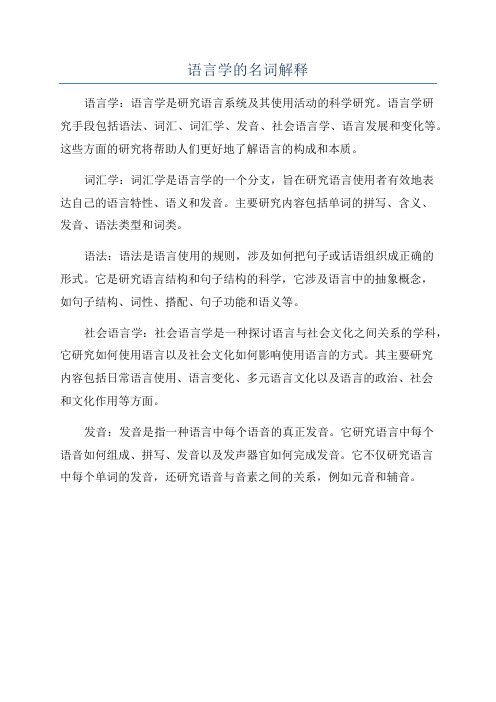
语言学的名词解释
语言学:语言学是研究语言系统及其使用活动的科学研究。
语言学研
究手段包括语法、词汇、词汇学、发音、社会语言学、语言发展和变化等。
这些方面的研究将帮助人们更好地了解语言的构成和本质。
词汇学:词汇学是语言学的一个分支,旨在研究语言使用者有效地表
达自己的语言特性、语义和发音。
主要研究内容包括单词的拼写、含义、
发音、语法类型和词类。
语法:语法是语言使用的规则,涉及如何把句子或话语组织成正确的
形式。
它是研究语言结构和句子结构的科学,它涉及语言中的抽象概念,
如句子结构、词性、搭配、句子功能和语义等。
社会语言学:社会语言学是一种探讨语言与社会文化之间关系的学科,它研究如何使用语言以及社会文化如何影响使用语言的方式。
其主要研究
内容包括日常语言使用、语言变化、多元语言文化以及语言的政治、社会
和文化作用等方面。
发音:发音是指一种语言中每个语音的真正发音。
它研究语言中每个
语音如何组成、拼写、发音以及发声器官如何完成发音。
它不仅研究语言
中每个单词的发音,还研究语音与音素之间的关系,例如元音和辅音。
语言学名词解释
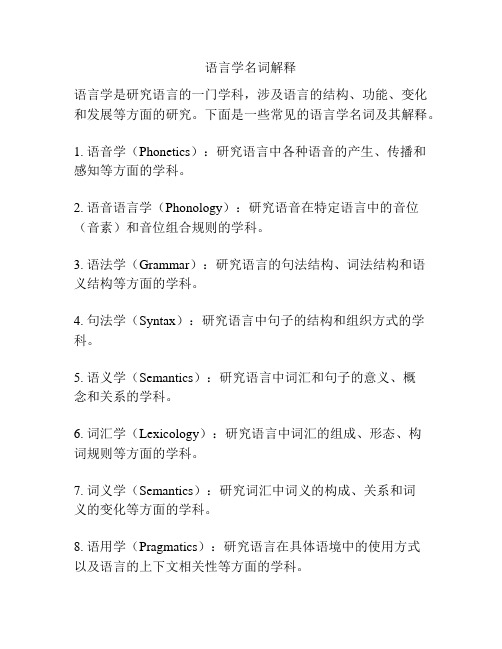
语言学名词解释语言学是研究语言的一门学科,涉及语言的结构、功能、变化和发展等方面的研究。
下面是一些常见的语言学名词及其解释。
1. 语音学(Phonetics):研究语言中各种语音的产生、传播和感知等方面的学科。
2. 语音语言学(Phonology):研究语音在特定语言中的音位(音素)和音位组合规则的学科。
3. 语法学(Grammar):研究语言的句法结构、词法结构和语义结构等方面的学科。
4. 句法学(Syntax):研究语言中句子的结构和组织方式的学科。
5. 语义学(Semantics):研究语言中词汇和句子的意义、概念和关系的学科。
6. 词汇学(Lexicology):研究语言中词汇的组成、形态、构词规则等方面的学科。
7. 词义学(Semantics):研究词汇中词义的构成、关系和词义的变化等方面的学科。
8. 语用学(Pragmatics):研究语言在具体语境中的使用方式以及语言的上下文相关性等方面的学科。
9. 文法学(Stylistics):研究语言使用中的文体、修辞手法、语言风格等方面的学科。
10. 母语(Mother tongue):一个人从小学会并用于日常交际的语言。
11. 第二语言(Second language):在学习者的母语之外学习的语言。
12. 语言接触(Language contact):不同语言之间在社会、文化接触中产生的相互影响和借用的现象。
13. 语言变异(Language variation):指同一个语言在不同社会、地理和使用者间发生的音、词、句法等方面的变化。
14. 语言变化(Language change):指语言在漫长的时间内逐渐变化和发展的过程。
15. 语言规范(Language standardization):制定和规范一个语言的正确用法、标准词汇和语法规则的过程。
16. 语言习得(Language acquisition):指儿童在自然环境中学习母语的过程。
《语言学纲要》187个名词解释

《语言学纲要》187个名词解释1.语言学语言学是以语言为研究对象的一门独立科学。
语言学的基本任务是研究语言的结构规律和演变规律,使人们懂得关于语言的理性知识,提高学习和运用语言的水平。
语言学分理论语言学和应用语言学两个领域。
2.专语语言学(具体语言学)以某一种具体的语言为研究对象的语言学。
它包括共时语言学和历时语言学两种。
总之,专语语言学只研究某一种语言。
★3.共时语言学是语言学的分支,从一个发展的横断面描写研究语言在某个历史时期的状态和发展。
如现代汉语、古代汉语。
★4.历时语言学语言学的分支,又叫历史语言学,是从纵向发展的角度研究某种语言从一个时代到另一个时代的发展变化。
5.语文学又叫传统语言学,用于指19世纪历史比较语言学产生之前的语言研究,这时的语言研究尚未独立,语言学作为其他学科的附庸存在,语言研究的主要是为了阅读古籍和语言教学,从而为统治者治理国家或为其他学科的研究服务。
☆6.“小学”在中国古代,“小学”先从教授字的形(六书)、音、义开始,就把研究文字、训诂、音韵方面的学问统称为“小学”。
“小学”一直是经学的一部分,包括音韵学、训诂学、文字学三个分支学科。
☆7.普通语言学以人类一般语言为研究对象,研究人类语言的性质、结构特征、发展规律,是综合众多语言的研究成果而建立起来的语言学,是语言学的重要理论部分。
☆8.理论语言学是普通语言学的一个部分,与应用语言学相对。
理论语言学主要以语言系统的描写、语言运用机制、语言能力以及语言发展的历史为主要研究对象。
☆9.应用语言学研究语言应用的学科,实际上是一种交叉学科,是相关学科的学者将语言学的基本原理同有关学科结合起来研究问题而产生的新的学科。
狭义的应用语言学是指语言教学(包括聋哑盲教学)、文字的创制和改革、正音正字、词典编撰等;广义的应用语言学还包括与计算机有关的机器翻译、情报检索、语音识别、自然语言处理等。
★10.历史比较语言学19世纪30年代兴起的一个语言学的重要流派,它以历史比较法为基础,研究具有共同母语的语言之间的亲属关系以及它们的历史发展。
语言学名词解释
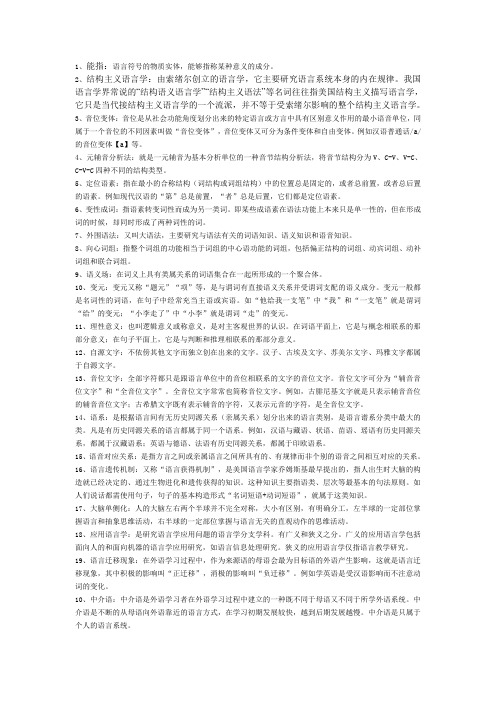
1、能指:语言符号的物质实体,能够指称某种意义的成分。
2、结构主义语言学:由索绪尔创立的语言学,它主要研究语言系统本身的内在规律。
我国语言学界常说的“结构语义语言学”“结构主义语法”等名词往往指美国结构主义描写语言学,它只是当代接结构主义语言学的一个流派,并不等于受索绪尔影响的整个结构主义语言学。
3、音位变体:音位是从社会功能角度划分出来的特定语言或方言中具有区别意义作用的最小语音单位,同属于一个音位的不同因素叫做“音位变体”,音位变体又可分为条件变体和自由变体。
例如汉语普通话/a/的音位变体【a】等。
4、元辅音分析法:就是一元辅音为基本分析单位的一种音节结构分析法,将音节结构分为V、C-V、V-C、C-V-C四种不同的结构类型。
5、定位语素:指在最小的合称结构(词结构或词组结构)中的位置总是固定的,或者总前置,或者总后置的语素。
例如现代汉语的“第”总是前置,“者”总是后置,它们都是定位语素。
6、变性成词:指语素转变词性而成为另一类词。
即某些成语素在语法功能上本来只是单一性的,但在形成词的时候,却同时形成了两种词性的词。
7、外围语法:又叫大语法,主要研究与语法有关的词语知识、语义知识和语音知识。
8、向心词组:指整个词组的功能相当于词组的中心语功能的词组,包括偏正结构的词组、动宾词组、动补词组和联合词组。
9、语义场:在词义上具有类属关系的词语集合在一起所形成的一个聚合体。
10、变元:变元又称“题元”“项”等,是与谓词有直接语义关系并受谓词支配的语义成分。
变元一般都是名词性的词语,在句子中经常充当主语或宾语。
如“他给我一支笔”中“我”和“一支笔”就是谓词“给”的变元;“小李走了”中“小李”就是谓词“走”的变元。
11、理性意义:也叫逻辑意义或称意义,是对主客观世界的认识。
在词语平面上,它是与概念相联系的那部分意义;在句子平面上,它是与判断和推理相联系的那部分意义。
12、自源文字:不依傍其他文字而独立创在出来的文字。
语言学纲要名词解释

语言学纲要名词解释语言学纲要名词解释:语言学:语言学是研究语言的科学,旨在探讨语言的结构、发展、使用和认知等方面的规律和现象。
声音:声音是由空气振动引起的,可通过耳朵感知得到的物理现象。
在语言学中,声音是语言的基本单位,用于构成语音。
语音:语音是语言学研究的一个分支,研究语言中的音素、音位等声音单位的特征和规律。
音素:音素是语音学研究的一个基本概念,指在一个语言中差异能够区分词义的最小声音单位。
语言声调:语言声调是描述不同语言或方言中声调变化和使用的规律和现象。
音韵学:音韵学是语言学中一个研究语音的分支,研究不同语音之间的相互关系和规律。
辅音:辅音是指在发音过程中需要舌头、唇等口腔器官接触或与之产生摩擦的音素。
元音:元音是指发音时空气通过喉咙、口腔等器官自由通过而不产生摩擦的音素。
音系:音系是指一个语言中所有音素的组合和制约关系。
语法:语法是研究语言结构和规则的科学,包括句法、词法等方面。
句法:句法是语法的一个分支,研究句子在语言中的组织结构和句子成分之间的关系。
词法:词法是研究词的结构和形态变化的学科,包括词的构成、词类等方面。
形态学:形态学是语言学研究的一个分支,研究词的形态构成、词的形态变化等现象。
句子:句子是语言中表达一个完整意思的基本单位。
意义:意义是语言符号所包含的符号和概念的含义。
语义学:语义学是研究语言符号意义的学科,包括词义学和句义学等方面。
语用学:语用学是研究语言使用情境和交际行为的学科,关注社会语言学、会话分析等方面。
会话分析:会话分析是语用学的一个分支,研究对话结构、对话参与者行为等方面。
语言地理学:语言地理学是研究语言在地理分布和变化中的规律和影响的学科。
语言变异学:语言变异学是研究语言变异和变体使用的学科。
语言习得:语言习得是研究人类如何学习和掌握第一语言和第二语言的过程和机制的学科。
语言分析:语言分析是对语言进行形态、句法、语用等方面的分析。
语言教学:语言教学是指通过教育和教学方法来教授和学习语言的过程。
语言学概论所有名词解释
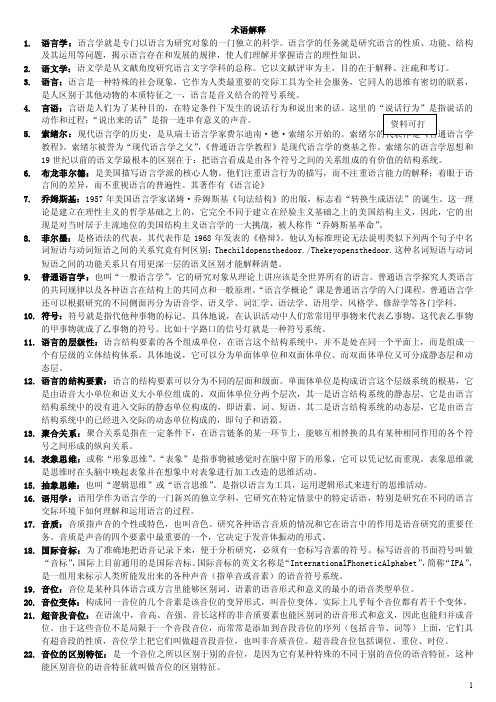
术语解释1.语言学:语言学就是专门以语言为研究对象的一门独立的科学。
语言学的任务就是研究语言的性质、功能、结构及其运用等问题,揭示语言存在和发展的规律,使人们理解并掌握语言的理性知识。
2.语文学:语文学是从文献角度研究语言文字学科的总称。
它以文献评审为主,目的在于解释、注疏和考订。
3.语言:语言是一种特殊的社会现象,它作为人类最重要的交际工具为全社会服务,它同人的思维有密切的联系,是人区别于其他动物的本质特征之一,语言是音义结合的符号系统。
4.言语:言语是人们为了某种目的,在特定条件下发生的说话行为和说出来的话。
这里的“说话行为”是指说话的5.索绪尔:教程》。
索绪尔被誉为“现代语言学之父”,《普通语言学教程》是现代语言学的奠基之作。
索绪尔的语言学思想和19世纪以前的语文学最根本的区别在于:把语言看成是由各个符号之间的关系组成的有价值的结构系统。
6.布龙菲尔德:是美国描写语言学派的核心人物。
他们注重语言行为的描写,而不注重语言能力的解释;着眼于语言间的差异,而不重视语言的普遍性。
其著作有《语言论》7.乔姆斯基:1957年美国语言学家诺姆·乔姆斯基《句法结构》的出版,标志着“转换生成语法”的诞生。
这一理论是建立在理性主义的哲学基础之上的,它完全不同于建立在经验主义基础之上的美国结构主义,因此,它的出现是对当时居于主流地位的美国结构主义语言学的一大挑战,被人称作“乔姆斯基革命”。
8.菲尔墨:是格语法的代表,其代表作是1968年发表的《格辩》。
他认为标准理论无法说明类似下列两个句子中名词短语与动词短语之间的关系究竟有何区别:Thechildopensthedoor./Thekeyopensthedoor.这种名词短语与动词短语之间的功能关系只有用更深一层的语义区别才能解释清楚。
9.普通语言学:也叫“一般语言学”,它的研究对象从理论上讲应该是全世界所有的语言。
普通语言学探究人类语言的共同规律以及各种语言在结构上的共同点和一般原理。
语言学名词解释
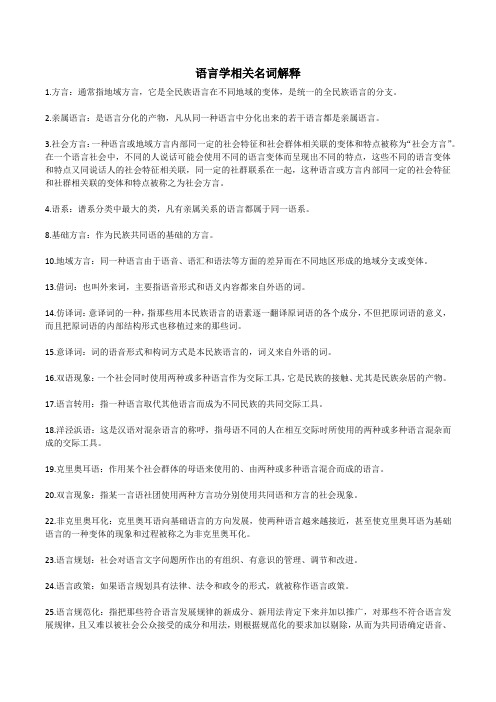
语言学相关名词解释1.方言:通常指地域方言,它是全民族语言在不同地域的变体,是统一的全民族语言的分支。
2.亲属语言:是语言分化的产物,凡从同一种语言中分化出来的若干语言都是亲属语言。
3.社会方言:一种语言或地域方言内部同一定的社会特征和社会群体相关联的变体和特点被称为“社会方言”。
在一个语言社会中,不同的人说话可能会使用不同的语言变体而呈现出不同的特点,这些不同的语言变体和特点又同说话人的社会特征相关联,同一定的社群联系在一起,这种语言或方言内部同一定的社会特征和社群相关联的变体和特点被称之为社会方言。
4.语系:谱系分类中最大的类,凡有亲属关系的语言都属于同一语系。
8.基础方言:作为民族共同语的基础的方言。
10.地域方言:同一种语言由于语音、语汇和语法等方面的差异而在不同地区形成的地域分支或变体。
13.借词:也叫外来词,主要指语音形式和语义内容都来自外语的词。
14.仿译词:意译词的一种,指那些用本民族语言的语素逐一翻译原词语的各个成分,不但把原词语的意义,而且把原词语的内部结构形式也移植过来的那些词。
15.意译词:词的语音形式和构词方式是本民族语言的,词义来自外语的词。
16.双语现象:一个社会同时使用两种或多种语言作为交际工具,它是民族的接触、尤其是民族杂居的产物。
17.语言转用:指一种语言取代其他语言而成为不同民族的共同交际工具。
18.洋泾浜语:这是汉语对混杂语言的称呼,指母语不同的人在相互交际时所使用的两种或多种语言混杂而成的交际工具。
19.克里奥耳语:作用某个社会群体的母语来使用的、由两种或多种语言混合而成的语言。
20.双言现象:指某一言语社团使用两种方言功分别使用共同语和方言的社会现象。
22.非克里奥耳化:克里奥耳语向基础语言的方向发展,使两种语言越来越接近,甚至使克里奥耳语为基础语言的一种变体的现象和过程被称之为非克里奥耳化。
23.语言规划:社会对语言文字问题所作出的有组织、有意识的管理、调节和改进。
语言学概论名词解释

语言学:是以语言作为专门研究对象的一门独立的科学;从方法上分为历史语言学、比较语言学、历史比较语言学、描写语言学;从研究对象上可分为个别语言学和普通语言学;19C 初的历史比较语言学标志着语言学的诞生。
语文学:是为给古代文化遗产,即政治历史文学等方面的经典书面著作作注释,目的是使人们可以读懂古书的一门尚未独立的学科。
“小学”:中国传统的语文学,围绕阐释和解读先秦典籍来展开研究,形成了文字学、音韵学、训诂学,分别探讨和研究汉字的字形、字音、字义。
专语语言学:以某种具体的语言为研究对象的语言学。
共时语言学、历时语言学:根据语言体系的稳固和变化,把语言研究分为共时的和历时的研究,。
共时语言学研究的是在特定时期内相对稳固的语言体系,如对现代汉语的研究;历时语言学研究的则是描写语言体系的历史演变,如对汉语发展史的研究。
普通语言学:是对人类语言从理论方面进行研究的一门学科,它探索各种语言所共有的规律以及各种语言在结构上的共同特点。
历史语言学:用历史的方法来考察语言的历史演变、研究它的变化规律的语言学。
比较语言学:用比较的方法,对不同的语言进行对比研究,找出它们相异之处或共同规律的语言学。
表层结构、深层结构:表层结构和深层结构相对,表层结构赋予句子以一定的语音形式,即通过语音形式所表达出来的那种结构,表层结构是由深层结构转换而显现的;深层结构是赋予句子以一定的语义解释的那种结构。
索绪尔:现代语言学的创始人,代表著作是《普通语言学教程》。
(简单要加补充) 语言的社会功能语言:就其本质而言,语言是一种音义结合的符号系统;就其社会功能来说,语言是一种特殊的社会现象,是人类最重要的交际工具和必不可少的思维工具。
言语:是对语言的运用,是语言的行为和结果。
说话:是人们运用语言工具表达思想所产生的结果。
思维:是人脑能动地反映客观现实的机能和过程。
根据思维活动的不同形态可分为三种类型:直观动作思维、形象思维、抽象思维。
语言学的名词解释

语言学的名词解释引言语言学是研究语言的结构、规律和变化的学科。
作为一门学科,语言学涉及广泛的领域,涵盖了词汇、语法、语音、语义等多个方面。
在语言学研究中,有许多重要的名词需要解释,这些名词有助于我们理解语言学的基本概念和理论。
本文将介绍几个语言学中常用的名词,并对其进行解释。
语音学1. 语音语音是指人类使用声音来进行交流和表达意思的能力。
在语音学中,语音是指语言的声音单位,包括语音的产生、分类和描述等方面。
2. 语音学语音学是研究语音的学科。
它研究语音的产生、传播、感知和分类等问题,对语音的音素、音节、音系等进行描述和分析。
3. 音素音素是语言中最小的音位单位。
一个音素可以通过替换使一个音与另外一个音有所区别。
音素可用于建立音位对比,对研究语音的差异和系统性做出描述。
4. 音节音节是语言中的基本语音单位。
它由一段连续的声音组成,包括一个或多个音素。
音节在构成词语时具有重要的作用,不同语言对音节的组合和结构有不同的规律。
语法学1. 语法语法是描述语言结构和规则的学科。
它研究语言中单词和句子之间的关系,以及语言的句法规则。
语法可以分为句法、词法、句子成分等多个层面。
2. 句法句法是语法学中研究句子结构和组织的分支。
它研究句子的成分和关系,包括主谓结构、宾语、修饰语等。
3. 词法词法是语法学中研究词汇和词法规则的分支。
它研究词汇的构成和分类,包括词根、词缀、词义等方面。
4. 句子成分句子成分是组成句子的不可再分的最小单位。
在句子中,包括主语、谓语、宾语、定语、状语等多个句子成分,它们各自具有不同的语法功能。
语义学1. 语义语义是研究词义和语言意义的学科。
它研究词汇和句子的意义,以及语言表达的信息和引申。
2. 语义学语义学是研究语言意义的学科。
它研究语言中的词义、句义、语境等方面的问题,揭示词语和句子的真正含义。
3. 词义词义是一个词所具有的意义。
在语义学中,词义可以通过定义、例句和语境等方式来解释和理解。
语言学名词解释
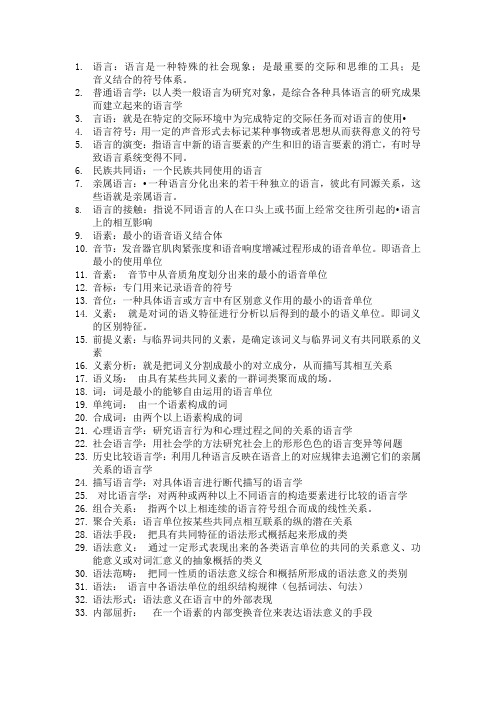
1.语言:语言是一种特殊的社会现象;是最重要的交际和思维的工具;是音义结合的符号体系。
2.普通语言学:以人类一般语言为研究对象,是综合各种具体语言的研究成果而建立起来的语言学3.言语:就是在特定的交际环境中为完成特定的交际任务而对语言的使用•4.语言符号:用一定的声音形式去标记某种事物或者思想从而获得意义的符号5.语言的演变:指语言中新的语言要素的产生和旧的语言要素的消亡,有时导致语言系统变得不同。
6.民族共同语:一个民族共同使用的语言7.亲属语言:•一种语言分化出来的若干种独立的语言,彼此有同源关系,这些语就是亲属语言。
8.语言的接触:指说不同语言的人在口头上或书面上经常交往所引起的•语言上的相互影响9.语素:最小的语音语义结合体10.音节:发音器官肌肉紧张度和语音响度增减过程形成的语音单位。
即语音上最小的使用单位11.音素:音节中从音质角度划分出来的最小的语音单位12.音标:专门用来记录语音的符号13.音位:一种具体语言或方言中有区别意义作用的最小的语音单位14.义素:就是对词的语义特征进行分析以后得到的最小的语义单位。
即词义的区别特征。
15.前提义素:与临界词共同的义素,是确定该词义与临界词义有共同联系的义素16.义素分析:就是把词义分割成最小的对立成分,从而描写其相互关系17.语义场:由具有某些共同义素的一群词类聚而成的场。
18.词:词是最小的能够自由运用的语言单位19.单纯词:由一个语素构成的词20.合成词:由两个以上语素构成的词21.心理语言学:研究语言行为和心理过程之间的关系的语言学22.社会语言学:用社会学的方法研究社会上的形形色色的语言变异等问题23.历史比较语言学:利用几种语言反映在语音上的对应规律去追溯它们的亲属关系的语言学24.描写语言学:对具体语言进行断代描写的语言学25.•对比语言学:对两种或两种以上不同语言的构造要素进行比较的语言学26.组合关系:指两个以上相连续的语言符号组合而成的线性关系。
语言学名词解释
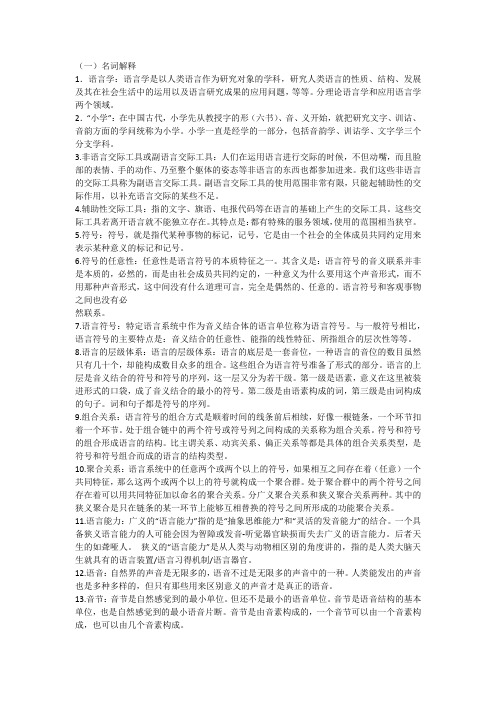
(一)名词解释1.语言学:语言学是以人类语言作为研究对象的学科,研究人类语言的性质、结构、发展及其在社会生活中的运用以及语言研究成果的应用问题,等等。
分理论语言学和应用语言学两个领域。
2.“小学”:在中国古代,小学先从教授字的形(六书)、音、义开始,就把研究文字、训诂、音韵方面的学问统称为小学。
小学一直是经学的一部分,包括音韵学、训诂学、文字学三个分支学科。
3.非语言交际工具或副语言交际工具:人们在运用语言进行交际的时候,不但动嘴,而且脸部的表情、手的动作、乃至整个躯体的姿态等非语言的东西也都参加进来。
我们这些非语言的交际工具称为副语言交际工具。
副语言交际工具的使用范围非常有限,只能起辅助性的交际作用,以补充语言交际的某些不足。
4.辅助性交际工具:指的文字、旗语、电报代码等在语言的基础上产生的交际工具。
这些交际工具若离开语言就不能独立存在。
其特点是:都有特殊的服务领域,使用的范围相当狭窄。
5.符号:符号,就是指代某种事物的标记,记号,它是由一个社会的全体成员共同约定用来表示某种意义的标记和记号。
6.符号的任意性:任意性是语言符号的本质特征之一。
其含义是:语言符号的音义联系并非是本质的,必然的,而是由社会成员共同约定的,一种意义为什么要用这个声音形式,而不用那种声音形式,这中间没有什么道理可言,完全是偶然的、任意的。
语言符号和客观事物之间也没有必然联系。
7.语言符号:特定语言系统中作为音义结合体的语言单位称为语言符号。
与一般符号相比,语言符号的主要特点是:音义结合的任意性、能指的线性特征、所指组合的层次性等等。
8.语言的层级体系:语言的层级体系:语言的底层是一套音位,一种语言的音位的数目虽然只有几十个,却能构成数目众多的组合。
这些组合为语言符号准备了形式的部分。
语言的上层是音义结合的符号和符号的序列,这一层又分为若干级。
第一级是语素,意义在这里被装进形式的口袋,成了音义结合的最小的符号。
第二级是由语素构成的词,第三级是由词构成的句子。
语言学的名词解释

语言学的名词解释序论部分语言学:是以语言作为专门研究对象的一门独立的科学;从方法上分为历史语言学、比较语言学、历史比较语言学、描写语言学;从研究对象上可分为个别语言学和普通语言学;19C初的历史比较语言学标志着语言学的诞生。
历史语言学:用历史的方法来考察语言的历史演变、研究它的变化规律的语言学。
比较语言学:用比较的方法,对不同的语言进行对比研究,找出它们相异之处或共同规律的语言学。
表层结构、深层结构:表层结构和深层结构相对,表层结构赋予句子以一定的语音形式,即通过语音形式所表达出来的那种结构,表层结构是由深层结构转换而显现的;深层结构是赋予句子以一定的语义解释的那种结构。
语言的社会功能语言的依存性(强制性):语言符号的音义结合是任意的,但一经社会约定俗成后,音义之间就具有互相依存的关系,不得任意更改。
语言层级性:语言是一种分层装置。
语言结构要素的各个单位,在语言结构中,并非处在同一个平面上,而是分为不同的层和级。
语言可分为二层——底层是一套音位和由音位组成的音节,为语言符号准备了形式部分;上层是音义结合的符号和符号的序列,分为三级:第一级是词素,是构词材料';第二级是词,是造句材料;第三级是句子,是交际的基本单位。
语言发展的渐变性:指语言从旧质过渡到新质不是经过爆发,不是经过消灭现存的语言和创造新的语言,而是经过新质要素的逐渐积累,旧质要素的逐渐死亡来实现的。
语言结构的体系的演变只能采取渐变,不能爆发突变。
语言发展的不平衡性:指语言结构体系发展变化是不平衡的,即词汇、语义、语音、语法的发展速度是不一样的。
与社会联系最直接的词汇、语义变化最快,语音次之,语法最慢。
组合关系:构成线性序列的语言成分之间前后相继的关系。
语言单位顺着时间的线条前后相继,好像一根链条,一环扣着一环,处于这个组合链中的两个符号或符号序列之间的关系就叫组合关系。
如:主谓、动宾等都是具体的组合关系类型。
聚合关系:在线性序列的某一结构位置上语言成分之间相互替换的关系。
语言学名词解释汇总

语言学名词解释汇总一、名词解释。
1、语言学:①~是以语言作为专门研究对象的一门独立的科学;②从方法上分为历史…、比较…、历史比较…、描写…;从研究对象上可分为个别…和普通…;③19世纪初的历史比较学标志着语言学的诞生。
2、语文学:…是为给古代文化遗产——政治历史文学等方面的经典书面著作作注释,目的是使人们可以读懂古书的一门尚未独立的学科。
3、小学:指我国古代传统的文学学、音韵学和训诂学,虽然我国古代没有语文学,但一般认为…属于语文学的范围。
4、训诂:是解释字义和研究它的演变的一门学科,其目的是从词义方面来解释古书的文字。
5、专语语言学:以某种具体的语言为研究对象的语言学称为…。
*共时语言学和历时语言学:根据语言体系的稳固和变化,把语言研究分为共时的和历时的研究,共时…研究的是在特定时期内相对稳固的语言体系,如对现代汉语的研究;历时…研究的则是描写语言体系的历史演变,如对汉语发展史的研究。
*普通语言学:是对人类语言从理论方面进行研究的一门学科,它探索各种语言所共有的规律以及各种语言在结构上的共同特点。
*历史语言学:用历史的方法来考察语言的历史演变、研究它的变化规律的语言学称为…。
*比较语言学:用比较的方法,对不同的语言进行对比研究,找出它们相异之处或共同规律的叫…。
6、表层结构和深层结构:表层结构和深层结构相对,表层结构赋予句子以一定的语音形式,即通过语音形式所表达出来的那种结构,表层结构是由深层结构转换而显现的;深层结构是赋予句子以一定的语义解释的那种结构。
7、语言:是从言语中概括出来的音义结合的词汇系统和语法系统。
*言语:是说的行为和结果。
*说话:是人们运用语言工具表达思想所产生的结果。
8、语言层级性(二层性):语言是一种分层装置。
语言结构要素的各个单位,在语言结构中,并非处在同一个平面上,而是分为不同的层和级。
语言可分为二层——底层是一套音位和由音位组成的音节;上层分为三级:第一级是词素,是构词材料';第二级是词,是造句材料;第三级是句子,是交际的基本单位。
语言学概论名词解释

语言学概论名词解释(一)1、【语言学】语言学是把语言作为研究对象的科学,是关于语言的理论知识。
+语言学是抽象应用性学科,语言学为语文教学服务,语言学为国家语文政策服务,语言学促进现代化建设2、【具体语言学】以某一种或一些具体语言为研究对象的语言学叫做具体语言学+具体语言学都是研究有关个别语言(或语系、语族)的特殊规律的。
3、【理论语言学】把具体语言研究的成果总结起来,找出语言的一般规律的学科是理论语言学(或普通语言学)。
+它在具体语言研究的基础上总结出一般规律,再用来指导具体语言的研究,理论语言学提供语言学的基本概念、有关语言的一般理论、模式和研究方法,通常包括语言结构的分析和描写的种种原则。
它的内容应该适用于所有或多数语言。
4、【历时语言学】也叫历史语言学,研究语言在不同阶段的历史演变,研究它的语音、语义或词汇、语法等从古到今的发展。
5、【共时语言学】也叫断代语言学,它研究某一时期的具体语言的结构状况。
6、【应用语言学】应用语言学是应用语言学成果于各种有关语言文字实际运用的学科。
+它包括语言教学、机器翻译、人机对话、情报检索、人工智能、词典编纂、文学创作技巧、失语症治疗等有关语言文字运用的研究。
7、【各种类型的语言学】研究语法构造的叫语法学;研究词汇的叫做词汇学;研究语音的语音学;研究语义的叫语义学;研究如何加强语言表现力的是修辞学;研究文字的是文字学。
8、【社会语言学】社会语言学是语言学同其他社会科学相交的边缘学科,建立于20世纪60年代。
+社会语言学的根本目的是要研究人们使用着的活生生的语言是什么样子,随哪些因素而起变化,有什么规律,因此它的研究课题十分广泛,另一方面,还可以研究社会现象及其发展过程在语言中的反映。
9、【心理语言学】心理语言学是语言学和心理学相交的边缘学科,20世纪50年代既已建立。
+心理语言学的研究内容主要是:语言的习得,语言的发生,语言的理解,语言与思维、智力的关系等。
语言学名词解释

名词解释结构语言学:又称结构主义语言学,是指20世纪以费尔迪南.德.索绪尔的语言学理论为代表以及受这种理论影响而发展起来的三大语言学派:布拉格学派、哥本哈根学派、美国描写主义语言学派。
共时语言学:从语言发展的一个横断面对一种语言在特定时期的相对静止的状态进行静态研究的语言学分支。
历时语言学:又叫历时语言学,是从纵向发展的角度研究某种语言从一个时代到另一时代的发展变化的语言学分支。
.语言:是一种特殊的社会现象,是人类最重要的交际工具和必不可少的思维工具,它是以语音为形式、以语义为内容、由词汇和语法构成的符号系统。
言语:是对语言的运用,它有两个意思:一是指运用语言(说话)和运用语言产生的结果(所说的话);二是指在运用文字的情况下,是写和写下来的话思维:是认识现实世界时的一种动脑筋的过程,也指动脑筋时进行比较、分析、综合以认识现实的能力。
是人脑能动地反映客观现实的机能和过程。
根据思维活动的不同形态可分为三种类型:直观动作思维、形象思维、抽象思维。
语言符号:语言是一种符号,因为它能代表或指称现象。
语言符号是由音义结合构成的。
音是语言符号的物质表现形式,义是语言符号的内容,只有音和义相结合才能指称现实现象,构成语言的符号。
语言符号的任意性:指语言符号的最大特点是它的音和义的结合时任意的,由社会约定俗成的。
它是就语言符号的音和义的相互关系来说。
这种音义的任意性关系又叫约定性。
语言符号的强制性:符号的任意性特点是就语言起源时的情况来说的,语言符号的音义结合是任意的,至于符号的音义关系一经社会约定而进入交际之后,对人们就有强制性,音义之间就具有互相依存的关系,不得任意更改。
语言符号的线条性:即语言符号的使用只能在时间的线条上绵延,一个符号跟着一个个符号依次出现。
依次出现的符号要遵守一定的规则,不能随意编排。
符号的线条性是由规则支配的,对社会成员具有强制性。
.语言结构的层级性:语言是一种分层装置。
语言结构要素的各个单位,在语言结构中,并非处在同一个平面上,而是分不同的层和级。
语言学纲要名词解释

语言学:顾名思义是研究语言的科学,语言是语言学的研究对象。
个别语言学:以某中见体语言作为研究对象的语言学叫做个别语言学又叫具体语言学。
汉语语言学、英语语言学、日语语言学都属于这一类。
普通语言学:以人类语言作为研究对象,探索各种语言共有的规律,以及各种语言在结构上的共同特点等,人类语言中共性的东西的语言学叫做普通语言学又叫一般语言学。
一般语言学划分为语音学、语义学、词汇学、语法学、风格学、修辞学,属于一般语言学。
历时语言学:研究某种语言在不同阶段的历史演变的语言学叫做历时语言学。
如:汉语史。
共时语言学:截取某种语言在历史发展中的某一阶段,做一个横断面剖析的语言学叫共时语言学。
如:汉语史。
比较语言学:用比较的方法对不同的语言进行对比研究,找出他们之间异同的语言学。
如汉英比较语言学。
历史语言学:运用比较的方法,来发现几种语言在历史演变过程中对应规律,从而拟测语言的亲属关系的语言学叫做历史语言学。
如汉藏语言学,印欧语言学。
感性思维:两种,狭义的感性思维:指运用感觉器官,感受到外界事物的活动。
它的特点是用感觉器官直接的感知思维对象,并通过思维的活动去影响思维对象。
包括:视觉和听觉嗅觉、触觉、知觉都属于它。
广义的感性思维:除了包括侠义的感性思维,还包括在头脑中唤起表象并在头脑中对表象进行加工改造的活动,这种思维加工叫表象思维。
抽象思维:又叫理性思维又叫逻辑思维指:从概念判断和推理逻辑形式进行的思维活动概念是用语言的词来表达的,判断是用语言的句子来表达的推理。
也是借助句子来表达的因此以语言为工具或语言的基础进行的活动。
因为语言是人类独自的能力,所以动物没有抽象思维。
如:老马识途,狐狸断运、黑猩猩学手语。
人有人言兽有兽语,语言是抽象思维的必要形式,但并不是抽象思维的唯一形式。
发散思维:1、也叫外思维活动,指随着感性认识和理性认识而产生的综合的心理活动。
如感情,意志,美感,文化传统等都属于文化思维。
对于下大雨这一现象人的情感不一样。
语言学的的名词解释是什么
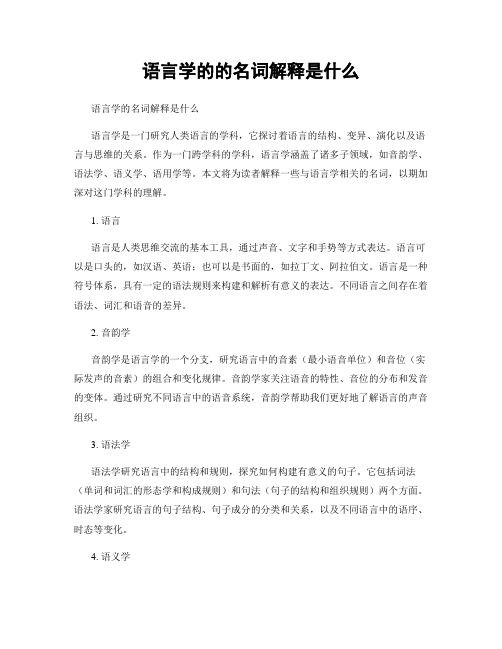
语言学的的名词解释是什么语言学的名词解释是什么语言学是一门研究人类语言的学科,它探讨着语言的结构、变异、演化以及语言与思维的关系。
作为一门跨学科的学科,语言学涵盖了诸多子领域,如音韵学、语法学、语义学、语用学等。
本文将为读者解释一些与语言学相关的名词,以期加深对这门学科的理解。
1. 语言语言是人类思维交流的基本工具,通过声音、文字和手势等方式表达。
语言可以是口头的,如汉语、英语;也可以是书面的,如拉丁文、阿拉伯文。
语言是一种符号体系,具有一定的语法规则来构建和解析有意义的表达。
不同语言之间存在着语法、词汇和语音的差异。
2. 音韵学音韵学是语言学的一个分支,研究语言中的音素(最小语音单位)和音位(实际发声的音素)的组合和变化规律。
音韵学家关注语音的特性、音位的分布和发音的变体。
通过研究不同语言中的语音系统,音韵学帮助我们更好地了解语言的声音组织。
3. 语法学语法学研究语言中的结构和规则,探究如何构建有意义的句子。
它包括词法(单词和词汇的形态学和构成规则)和句法(句子的结构和组织规则)两个方面。
语法学家研究语言的句子结构、句子成分的分类和关系,以及不同语言中的语序、时态等变化。
4. 语义学语义学关注语言中词汇和句子的意义,研究语言符号和其所表示的概念之间的关系。
语义学家探讨语言中的词义、句义和逻辑推理。
通过研究语义学,我们可以理解为什么同一个概念在不同语言中可能有不同的表达方式。
5. 语用学语用学研究语言在特定上下文中的使用和理解,关注言语行为的目的、意图和效果。
语用学家研究言语行为规范、会话合作原则、语用推理等。
语用学帮助我们理解为何同样的句子在不同场景中可能有不同的含义。
6. 语言演化语言演化研究语言的变化和发展,探寻语言是如何从一个共同的祖先语言发展出多样的语言家族。
语言演化研究领域包括比较语言学、历史语言学和古代语言学等。
通过研究语言的演化,我们可以了解语言是如何随时间变化的,为什么不同语言之间存在相似性和差异性。
语言学名词解释
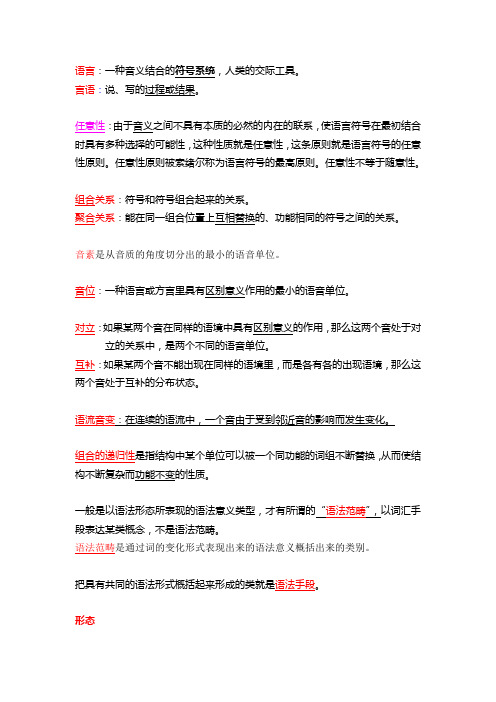
语言:一种音义结合的符号系统,人类的交际工具。
言语:说、写的过程或结果。
任意性:由于音义之间不具有本质的必然的内在的联系,使语言符号在最初结合时具有多种选择的可能性,这种性质就是任意性,这条原则就是语言符号的任意性原则。
任意性原则被索绪尔称为语言符号的最高原则。
任意性不等于随意性。
组合关系:符号和符号组合起来的关系。
聚合关系:能在同一组合位置上互相替换的、功能相同的符号之间的关系。
音素是从音质的角度切分出的最小的语音单位。
音位:一种语言或方言里具有区别意义作用的最小的语音单位。
对立:如果某两个音在同样的语境中具有区别意义的作用,那么这两个音处于对立的关系中,是两个不同的语音单位。
互补:如果某两个音不能出现在同样的语境里,而是各有各的出现语境,那么这两个音处于互补的分布状态。
语流音变:在连续的语流中,一个音由于受到邻近音的影响而发生变化。
组合的递归性是指结构中某个单位可以被一个同功能的词组不断替换,从而使结构不断复杂而功能不变的性质。
一般是以语法形态所表现的语法意义类型,才有所谓的“语法范畴”,以词汇手段表达某类概念,不是语法范畴。
语法范畴是通过词的变化形式表现出来的语法意义概括出来的类别。
把具有共同的语法形式概括起来形成的类就是语法手段。
形态同一个词的不同变化形式,这也是一种类聚。
词义:是词的语音形式所承载的内容,是人脑对外部世界的反映。
文字是记录语言的书写符号系统,是人类最重要的辅助性交际工具。
方言是指只通行于一定地域的某种语言,相对于共同语来说,它是一种语言的低级形式。
共同语是指一个社会打破地域隔阂、走向统一时出现的语言形式,对方言来说是一种语言高级形式。
地域方言是指全民语言在不同地域上所产生的各有自己特点的语言分支或者语言变体。
亲属语言是指从同一种语言分化出来的,彼此有同源关系的几种独立语言。
语言融合是一种语言排挤和替代其他语言而成为不同民族的共同交际工具。
- 1、下载文档前请自行甄别文档内容的完整性,平台不提供额外的编辑、内容补充、找答案等附加服务。
- 2、"仅部分预览"的文档,不可在线预览部分如存在完整性等问题,可反馈申请退款(可完整预览的文档不适用该条件!)。
- 3、如文档侵犯您的权益,请联系客服反馈,我们会尽快为您处理(人工客服工作时间:9:00-18:30)。
1.Semantics: the study of meaning2.Synonymy: the sameness or close similarity of meaning.3.Polysemy: while different words may have the same or similar meaning, the same one word may have more than one meaning4.Homonymy: the phenomenon thea words having different meanings have same form, i.e.,different words are identical in sound or spelling, or in both5.Hyponymy: the sense relation between a more general, more inclusive word and a more specific word6.Antonymy: words that are opposite in meaning7.Pragmatics: it is the study of how speakers of a language ues sentences to effect successful communication8.Speech act theory: it is a philosopher explanation of the nature of linguistic communicatin. It is aim to answer the question “what do we do when suing lanfuage?”9.Constatives: either state or discribe, and were thus verifiable10. Performatives: did not state a face or describe a state, and were not verifiable11.Locutionary act: It is the act of utterance words,phrases,clauses. It is the act of conveying literal meaning by means of syntax, lexion and phonology.12.Illocutionary act: It is the act expressing the speaker’s intention; It is the act performed in saying something.13.Perlocutionary act: It is the act performed by or resulting from saying something: it is the consequence of, or the change brought about by the utterance; it is the act performed by saying something14.cooperative principle: in making conversation, the participants must first of all be willing to coopreate; otherwise, it would not be possible for them to carry on the talk15.historical linguistics:it is the subfield of linguistics that studies language change.16.blending: a way of forming a new word by combining parts of two other words17.semantic broadening:the process in which the meaning of a word becomes general or inclusive than its historically earlier meaning18.protolanguage: the original form of a language family which has ceased to existnguage family: a group of historically relate laguages that have developed from a common ancestral language20.socilinguistics: the subdiscipling of linguistics thet studies language variation and language ues in social contexts21.speech community: a group of people who form a community andshare at least one speech variety as well as similar linguistic norms22.lingua franca: a variety of language that serves as a sommon speech for social contact among groups of people who speak different native languages or dialects23.pidign:a marginal contact language with a limited vocabulary and reduced grammatical structures, used by native speakers of other languages as a means of business communication24.diglossia: a sociolinguistic situation in which two very different varieries of languag co-exist in a speech community, each serving a particular social function and used for a particular situation25.euphemism:a word or expression that is thought to be mild, indirect, or less offensive and used as a polite substitute for the supposedly harsh and unpleasant word or expression26.psycholinguistics: the study of language in relation to the mind, with focus on the processes of language production, comprehension and acquisition27.cerebral cortex: the outside surface of the brain which receives messages from all the sensory oragns and where human cognitive abilities reside28.brain lateralization: The localization of cognitive of cognitive and percpetual functions in a particular hemisphere of the brain29.linguistic lateralization: hemispheric specialization or dominance forlanguage30.the critieal period: an early period of one’s life extending to the age of puberty, during which the human brain is most ready to acquire language naturally and effortlessly, a period that coincides with the period of brain lateralization for language functions31.caretaker speech: simple, modified speech used by parents, baby-sitter, etc.when they talk to young children who are acquiring their native languagenguage transfer:the effect of one’s first language knowledge on the learning of a second language33.interlanguage:the aproximate language system that a second language learner constructs which represents his or her transitional competence in the target language34.acculturation: a process of adapting to the culture and value system of the second language communnity。
